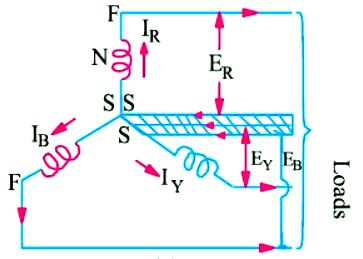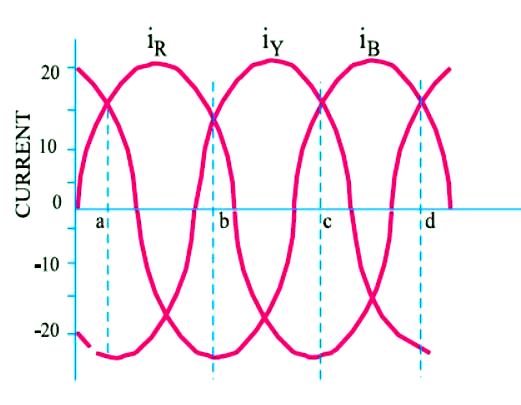Star or Wye Connection and Values of Phase Currents
In this article we will discuss the Star or Wye Connection and Values of Phase Currents.
Star or Wye Connection
In this method of interconnection, the similar* ends say, ‘star’ ends of three coils (it could be ‘finishing’ ends also) are joined together at point N as shown in Figure (A).
The point N is known as star point or neutral point. The three conductors meeting at point N are replaced by a single conductor known as neutral conductor as shown in Figure (B). Such an interconnected system is known as four-wire, 3-phase system and is diagrammatically shown in Figure (B). If this three-phase voltage system is applied across a balanced symmetrical load, the neutral wire will be carrying three currents which are exactly equal in magnitude but are 120° out of phase with each other. Hence, their vector sum is zero.
i.e. IR + IY + IB = 0 …………………….. vectorially
The neutral wire, in that case, may be omitted although its retention is useful for supplying lighting loads at low voltages. The potential difference between any terminal (or line) and neutral (or star) point gives the phase or star voltage. But the potential difference between any two lines gives the line-to-line voltage or simply line voltage.

Values of Phase Currents
When considering the distribution of current in a 3-phase system, it is extremely important to bear in mind that :
(i) the arrow placed alongside the currents IR IY and IB flowing in the three phases [Figure (B)] indicate the directions of currents when they are assumed to be positive and not the directions at a particular instant. It should be clearly understood that at no instant will all the three currents flow in the same direction either outwards or inwards. The three arrows indicate that first the current flows outwards in phase R, then after a phase-time of 120°, it will flow outwards from phase Y and after a further 120°, outwards from phase B.
AdBlock-2

(ii) the current flowing outwards in one or two conductors is always equal to that flowing inwards in the remaining conductor or conductors. In other words, each conductor in turn, provides a return path for the currents of the other conductors.
In Figure (C) are shown the three phase currents, having the same peak value of 20 A but displaced from each other by 120°. At instant ‘a’, the currents in phases R and B are each + 10 A (i.e. flowing outwards) whereas the current in phase Y is – 20A (i.e. flowing inwards). In other words, at the instant ‘a’, phase Y is acting as return path for the currents in phases R and B.
At instant ‘b’, IR = +15 A and IY = +5 A but IB = –20A which means that now phase B is providing the return path.

At instant c, IY = +15 A and IB = +5A and IR = – 20A.
Hence, now phase R carries current inwards whereas Y and B carry current outwards. Similarly at point d, IR = 0, IB = 17.3 A and IY = – 17.3 A. In other words, current is flowing outwards from phase B and returning via phase Y.
In addition, it may be noted that although the distribution of currents between the three lines is continuously changing, yet at any instant the algebraic sum of the instantaneous values of the three currents is zero
i.e. iR + iY + iB = 0 ………………………………. algebraically.
Read article – The potential difference
Visit NCERTplanet.com for NCERT solutions and Textbook downloads




